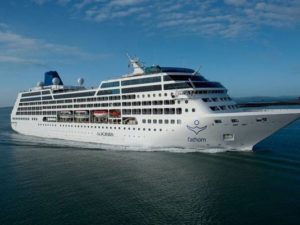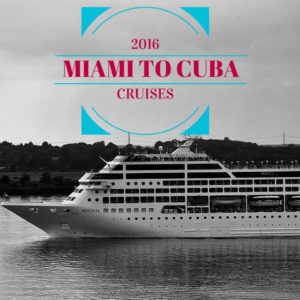HISTORICAL MOMENT, A U.S. CRUISE TRAVEL TO CUBA WITHOUT TOURIST.
North American passengers on the ship which sets sail this Sunday from Miami will travel with “cultural exchange” programs by the rules of the embargo.
The Adonia will be tonight when you release the moorings in the port of Miami, the first cruise on set sail from United States bound for Cuba in five decades. It will be possible thanks to the thaw in diplomatic relations between the two countries, announced to the world on December 2014 and certified by the historic visit of last March of Barack Obama to the island. So Cubans can go on board, it was necessary that the Castro Government amended the limitations that put their own citizens to access the island. On the other hand, given the restrictions in force by the embargo on the island, no American can still travel as a tourist.
Among the agreements that the former foes of the cold war have been adopting throughout the process of reunion, figure both facilitate travel from one to another country by air as maritime. Several companies have already shown their interest by launch regular flights, while the Carnival company, is the first that will seize new opportunities opening for the cruise business with the Adonia, of its new Fathom line.
The project was almost wrecked by the obstacles that Cuba was still putting citizens of Cuban origin. A decree adopted shortly after the 1959 Revolution forbade them to enter or leave the island by sea and Carnival, closing to that legislation, initially did not sell tickets to those born in Cuba. The reactions in Miami, Cuban exile bastion, were swift and organized protests by what has come to brand “apartheid”. Even the Secretary of State of the USA, John Kerry, condemned in a visit to Miami that the company applied this discriminatory measure in the sale of tickets.
The pressures made Carnival rectified and will begin taking pre-orders for the Cubans, so passing Castro authorities responsible for denying them access. Finally, La Habana took the step and changed the old Decree, allowing Cubans to enter and exit, as passengers or crew members, cruise ships or merchant, and gradually also in yates. The President of Carnival, Arnold Donald, welcomed because his company was “doing history” and «contributing to a future positive».
Educational purposes
In the meantime, while it’s a cruiser, which is supposed an eminently playful end, USA only allows embark American citizens that to use any of the twelve categories allowed to travel to Cuba, including the religious, family, journalistic or cultural reasons, but in any case the tourist. This means that many of the passengers have to look a convoluted subterfuge to camouflage his trip an educational or cultural purpose.
The website of Fathom’s Carnival line offers to passengers ‘Exchange programs’ included in the price allowing to comply with requirements that attaches of the US Treasury Department so that the activities carried out in Cuba are considered to be educational. Moreover, passengers with this category should have a comprehensive plan of activities that will develop, with contacts ranging to establish with the local population and after the trip keep the documentation activities carried out over five years.
The first Cruiser from U.S. to Cuba in decades will have a week-long and will make stops in La Habana, Cienfuegos and Santiago de Cuba. With capacity for more than 700 passengers, the Adonia offers various options of entertainment and services such as restaurants, bars, swimming pools and gym. The minimum price they are currently tickets for this destination, which will set sail every two weeks, is 2,100 dollars, although the suites can overcome the 9,000.
Agencies / ABC, Spain/Manuel Trillo/Excerpts/InternetPhotos/YouTube/TheCubanHistory.com
The Cuban History, Hollywood.
Arnold Varona, Editor.
MOMENTO HISTÓRICO, UN CRUCERO DE EEUU-CUBA SIN TURISTAS.
Los pasajeros norteamericanos en el barco que zarpa este domingo desde Miami viajarán con programas de «intercambio cultural» por las normas del embargo.
El Adonia se convertirá esta tarde, cuando suelte las amarras en el puerto de Miami, en el primer crucero en zarpar desde Estados Unidos con destino a Cuba en cinco décadas. Será posible gracias al deshielo en las relaciones diplomáticas entre ambos países, anunciado al mundo en diciembre de 2014 y certificado por la histórica visita del pasado mes de marzo de Barack Obama a la isla. Para que los cubanos puedan ir a bordo, ha sido necesario que el gobierno castrista modifique las limitaciones que ponía a sus propios ciudadanos para acceder a la isla. Por otra parte, dadas las restricciones vigentes por el embargo a la isla, ningún estadounidense podrá aún viajar como turista.
Entre los acuerdos que han ido adoptando los antiguos enemigos de la Guerra Fría a lo largo de su proceso de reencuentro, figura facilitar los viajes de uno a otro país tanto por vía aérea como marítima. Varias compañías han mostrado ya su interés por poner en marcha vuelos regulares, mientras que la empresa Carnival, es la primera que va a aprovechar con el Adonia, de su nueva línea Fathom, las nuevas oportunidades que se abren para el negocio de los cruceros.
El proyecto estuvo a punto de naufragar por las trabas que Cuba seguía poniendo a los ciudadanos de origen cubano. Un decreto aprobado poco después de la revolución de 1959 les prohibía entrar ni salir de la isla por vía marítima y Carnival, plegándose a esa normativa, en un principio no vendía billetes a los nacidos en Cuba. Las reacciones en Miami, bastión del exilio cubano, no se hicieron esperar y se organizaron protestas por lo que se llegó a tildar de “apartheid». Incluso el secretario de Estado de EE.UU., John Kerry, condenó en una visita a Miami que la compañía aplicara esa medida discriminatoria en la venta de pasajes.
Las presiones hicieron que Carnival rectificara y empezara a aceptar reservas de los cubanos, traspasando así a las autoridades castristas la responsabilidad de negarles el acceso. Finalmente, La Habana dio el paso y cambió el antiguo decreto, permitiendo a los cubanos que puedan entrar y salir, como pasajeros o como tripulantes, en cruceros o mercantes, y de forma gradual también en yates. El presidente de Carnival, Arnold Donald, se felicitó porque su compañía estaba «haciendo historia» y «contribuyendo a un futuro positivo».
Fines educativos
Entre tanto, a pesar de que se trata de un crucero, al que se le supone un fin eminentemente lúdico, EE.UU. solo permite embarcar a los ciudadanos estadounidenses que se acojan a alguna de las doce categorías permitidas para viajar a Cuba, entre ellas los motivos religiosos, familiares, periodísticos o culturales, pero en ningún caso los turísticos. Ello hace que muchos de los pasajeros tengan que buscarse un alambicado subterfugio para camuflar su viaje con un fin educativo o cultural.
La propia web de la línea Fathom de Carnival ofrece a los pasajeros «programas de intercambio» incluidos en el precio que permiten cumplir con los requisitos que fija el Departamento del Tesoro norteamericano para que las actividades que se desarrollen en Cuba se consideren educativas. Es más, los pasajeros acogidos a esta categoría deben tener un plan completo de las actividades que van a desarrollar, con los contactos que van a establecer con la población local y tras el viaje conservar durante cinco años la documentación relativa a las actividades que se han realizado.
El primer crucero de EE.UU. a Cuba en décadas tendrá una semana de duración y hará escalas en La Habana, Cienfuegos y Santiago de Cuba. Con capacidad para más de 700 pasajeros, el Adonia ofrece distintas opciones de entretenimiento y servicios como restaurantes, bares, piscinas y gimnasio. El precio mínimo al que están en la actualidad los billetes para este destino, al que se zarpará cada dos semanas, es de 2.100 dólares, aunque las suites pueden superar los 9.000.
Agencies/ABC, Spain/Manuel Trillo/Excerpts/InternetPhotos/YouTube/TheCubanHistory.com
The Cuban History, Hollywood.
Arnoldo Varona, Editor.



 HISTORICAL MOMENT, a U.S. Cruise Traveling to Cuba without Tourist. VIDEO. *** Momento Historico, un Crucero de EEUU-Cuba sin Turistas.VIDEO.
HISTORICAL MOMENT, a U.S. Cruise Traveling to Cuba without Tourist. VIDEO. *** Momento Historico, un Crucero de EEUU-Cuba sin Turistas.VIDEO.


